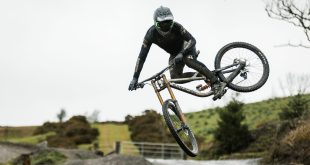In October, Advanced Sports of Philadelphia announced it had purchased Breezer, the transport bike brand owned by MTB pioneer Joe Breeze. He stays as on as a consultant.
Breeze, of Marin County, California, began building road racing frames in 1974. In 1977, he designed and built what are considered the first modern mountain bikes, called Breezers. Along with Gary Fisher, Charlie Kelly and Tom Ritchey, he helped create the mountain bike market and develop its early products. He launched a line of Breezer transportation bikes in 2002.
Advanced Sports owns the Fuji and Kestrel bicycle brands.
Pat Cunnane, president of Advanced Sports, says: “Joe is a pioneer – he introduced great mountain bike products to a market that wasn’t actually ready – and, for the last ten years, he has again been creating a new market for transportation bikes.
Advanced Sports is aiming to expand the international distribution of Breezer, including into the UK.
Did Breezer bikes benefit from the petrol price hikes of the summer? And was the sale to ASI in order to better fulfil demand?
Joe: Breezer sales increased 40 per cent from May to August during the petrol price surge. There are, of course, many vectors pointing to everyday biking as an excellent solution regarding personal health, environmental health and fiscal health. The secret is getting out, and yes, Breezer needed a way to take it to the next level. Advanced Sports’ president, Pat Cunnane, understands the emerging transportation sector probably better than any player in the bike biz.
Pat: Yes, we plan to ramp up production. This has already begun, Advanced Sports, Inc. (ASI) shareholder Ideal Bike Corporation has been the longtime manufacturer of Breezer bikes. The transition is going very smoothly.
Journeys by bike in the US are one to two per cent. How quickly will that rise to two to four per cent? And is there a ceiling?
Joe: In Davis, California (pop. 65,000) trips by bike represent 17 per cent of the mix. In Boulder, Colorado (pop. 280,000) the bike percentage is ten per cent, and in Portland, Oregon (pop. 570,000) it’s over five per cent. Boulder’s master plan aims for 15 per cent of all trips to be by bike by 2020.
Pat: There are already places where usage is well above four percent. We look at the Netherlands, where journeys by bike are almost 25 per cent, and learn what they have done and share that information here. Of course there is a ceiling; some travel is more practical by air, train or car. But we have a long way to go before we have to worry about the ceiling.
What are your views on electric bikes? Saviour or part of the problem?
Joe: Electric bikes stand to significantly broaden the use of bicycles. For many people, e-bikes make bicycling practical in hillier areas, for longer distances or whenever speed and/or less sweat is desired. The pedelec type, where the rider’s pedaling is added to, is best. I was less enthusiastic about e-bikes until I realised that influential people living on hills mattered to the future of everyday cycling. They may feel there is no hope for their cycling for everyday trips, ergo, no potential as a broad solution.
Luke Ellrath (Breezer bikes brand manager for ASI): Any way to get more people who may be reluctant/app-rehensive/resistant to ride on a bike and out of a car is positive. Many people have what they believe to be valid reasons to not ride in certain circumstances – too many hills, too heavy a load, not in good physical shape, simply tired, etc.
An electric bike addresses these obstacles to people who would otherwise be receptive to using a bicycle as practical transportation. It may be a better way to get to an evening out to dinner without arriving sweaty and dishevelled. It may be a way to get to and from grocery shopping without the hassle of finding parking or paying for gas. It may be the needed assist to carrying a heavy load (from a home improvement store) via a cargo bike platform.
By removing these barriers to beginner or returning riders we have the opportunity to get more people riding, more people fit and more people confident and ready to use a standard bicycle for more trips.
Pat: In Europe, where we sell bikes and will be expanding the Breezer market, there is an existing market for quality, electric bikes.
Trek CEO John Burke famously once said: “The number one way to grow the business and to have an impact on society, health, environment and congestion is to create a bicycle-friendly world." He said that for every $100 of sales, bike companies typically spend $3.90 on marketing, $1.60 on R&D but just ten cents on advocacy. What are your views on that?
Joe: Until recently, there wasn’t a real cohesive force pushing cycling in the US. Since 1995, Bikes Belong, an industry-level amalgamation of bike associations advocating for ‘more people on bikes more often,’ has taken up the charge. Bike companies are getting on board financially, attending the annual National Bike Summit in Washington, DC, and making their desires known. The effort has been very successful.
Pat: John Burke’s got it right and he’s proven himself to be a real leader in the bicycle industry. We are happy to follow some of his initiatives – for example, John led by donating one dollar to the League of American Bicyclists for every helmet sold; we implemented the same programme.
Chicken and egg: what is needed first – bike routes or better urban transport bikes?
Joe: Both. In some locales, reasonably safe and convenient routes can be found that are suitable for some people right now. In those instances, a bike useful for everyday riding (i.e., with racks, mudguards, lights, etc.) can catalyse greater bike use, which can inspire others to ride who then will demand safer and more convenient infrastructure for the masses. In areas where cycling is a dismal prospect, some groundwork may be in order first.
Pat: We need to make sure consumers are aware of the bicycle products and facilities that are available. We need to make cycling look approachable and attractive to those who currently don’t cycle. It goes back to what continues to be proven in studies – the more people that ride, the safer it is for people to ride.
Urban transportation bikes are not new, and while improvement is part of the bicycle industry culture, there are products on the market that are great. One obstacle we need to overcome is to let consumers know these products are available. Many current bicycle retailers are focused on the enthusiast and existing markets. This is our core – I believe as an industry we can focus less on them, and focus more on attracting new consumers to cycling. If we get more people riding regularly they will demand and get better facilities.
What are the international plans for Breezer bikes, especially in the UK?
Pat: The international plans are to establish distribution as quickly as we can. We have already started conversation with our current contacts in the UK and Europe and we’ve had numerous requests for the ‘Joe Breeze Mountain Bike’ throughout Europe.
Advanced Sports’ plan is to use Breezer as its transportation bike product line worldwide.
Joe, you’ve been quoted as saying transport bikes will be bigger than mountain bikes of the ‘80s and ‘90s. What should bike shops be doing to increase the size of the bike transport market?
Joe: From my initial mountain biking in 1973 to the point where MTB sales overtook road bike sales was about 15 years. The gestation of long-term change can be considerable. I remember dealers asking me, well into the 1980s, if I was still working on mountain bikes (which they thought would go nowhere). The changeover can be swift though. Once a dealer, and more importantly, the staff, give it a go, there’s no looking back.
Each bike requires that shops understand the potential. As many people who are riding today, I see them as just ten per cent of the potential of people who could be riding here someday.
When dealers offer bikes right on the showroom floor that are designed for everyday use – bikes that put bicycling more on the order of eating and breathing – many people will opt to get healthy while they get where they are going. Dealer outreach will help and the results may surprise us all.
Pat: Bike retailers really need to invest by dedicating part of their floor space to new categories of products including transportation bikes. Bike dealers have to look at what the future can be and that includes bikes for transportation. They don’t have to make up a future, they can look to Europe – in Germany, 50 per cent of bicycle sales are through independent bicycle dealers and 14 per cent of trips are by bike; in the Netherlands 80 per cent of bicycle sales are through the independent bicycle dealers and almost 25 per cent of trips are by bike. Contrary to the US, where about one per cent of trips are by bike and less than 25 per cent are sold through independent dealers.
There is a direct correlation between how many trips are taken by bike and the percentage of bikes that are sold through independent bicycle dealers. Supporting the growth of the bicycle transportation market is ensuring the future of the IBD.
 BikeBiz Bicycle and cycling retail news
BikeBiz Bicycle and cycling retail news



